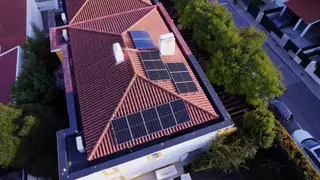The rays of sunlight shining on to the roof of Caxias Municipal Market, in Oeiras, represent the potential of the Caxias Living Lab project, an energy community created by Galp to test innovative solutions. Inside, several small producers have joined forces and will spend the next few years producing and sharing green energy among themselves in accordance with each person’s needs.
This network of neighbours is made up of twenty buildings and ten producers of renewable energy generated from a facility consisting of two hundred photovoltaic panels designed to benefit every single participant. The secret to success lies in bringing together individuals with different consumption patterns, whereby the excess energy produced by one person can be used by a neighbour in real time.
The Caxias Living Lab has brought together several small producers interested in generating green energy and sharing it among themselves
But how does this actually work? Sérgio Santos, one of the members of the Caxias Living Lab, explains that the aim “is to optimise energy production and consumption by creating a mixed community”. This network of producers and consumers is made up of members like Sergio Santos, who works from home and is therefore able to take advantage of the energy produced by the photovoltaic panels when the sun is shining. “Some people live in flats and can’t install panels, but they can benefit from the energy produced by people in possession of this equipment”, he adds.

The Caxias Living Lab has two hundred photovoltaic panels installed in a community in which the excess energy produced can be used by any of the participants in the project
Let's have a look at some practical examples. Another of this community's neighbours is the Nossa Senhora das Dores Parish Community Centre (CCPNSD), the nature of which involves a very different, more demanding pattern of consumption than that of Sérgio Santos. “Galp offered to install the panels. In return, we share our consumption data and supply our neighbours with energy”, the director of CCPNSD tells Energiser. Inês Franco Frazão’s enthusiasm is evident and it´s easy to see why: “in addition to saving on energy bills, we are improving the environment through the production of green energy and reinforcing the community spirit”.
In both cases, the reduction in energy costs is expected to range between 30% and 35%, depending on the use of each member of the Caxias Living Lab. In total, the project will prevent the emission of around 20 tons of CO2.

Ana Casaca, director of Innovation at Galp, highlighted the role of Caxias Living Lab on the road to energy transition at the project presentation event
The energy generated by the photovoltaic panels powers electric water heaters, heat pumps and electric vehicle chargers. Once each user’s consumption needs have been met, the energy is then stored in decentralised batteries located throughout the community. As far as Galp is concerned, this investment makes perfect sense, as it enables the company to test innovative solutions and collect data to improve this decentralised production model, but also to popularise this type of solution and provide it to more consumers in the near future.

The energy generated by photovoltaic panels can be used to power electric vehicle chargers, water heaters and heat pumps
“At the Parish Centre, for example, it proved impossible to install panels on the roof, reason for which Galp took an unprecedented step and installed the panels in a vertical position”, explained Carla Tavares, director of Galp’s Renewables and Commercial Innovation Centres. The name of the project is no coincidence, explains Ana Casaca, director of Innovation at the energy company. “Caxias Living Lab has a laboratory focus, and is geared to continuous improvement and experimentation with users. It symbolises Galp’s spirit of openness to the outside world, its desire to learn from the community and, above all, its commitment to co-creating the energy system of the future with citizens”, she highlights.
The Caxias Living Lab is currently made up of several producers and consumers, namely the Nossa Senhora do Vale Primary School and Kindergarten, the CCPNSD, Caxias Municipal Market and several private homes in the neighborhood. “I’m very happy to be able to use this equipment and to know how to organise my life to maximise the potential of these photovoltaic panels”, concludes Sérgio Santos.